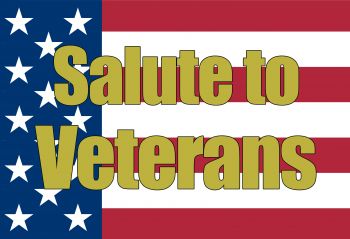Salute to Veterans: 11•11•18
American Fanfare, by John Wasson
John Wasson (b. 1956) was born and raised in St. Paul, Minnesota, and attended college at the University of North Texas, where he earned degrees in music theory and trombone performance. Wasson has been associated with the Dallas Brass, a renowned brass quintet, for more than 30 years, both as a charter performing member and as the primary composer and arranger. He originally wrote “American Fanfare” for the Dallas Brass and later adapted it for band. It has been described as “a bold, patriotic piece.”
The Star-Spangled Banner, by F. S. Key and J. S. Smith
Francis Scott Key (1779–1843), an American lawyer and amateur poet, wrote the poem “Defence of Fort M’Henry” after witnessing the bombardment of the Baltimore fort by the British Navy during the War of 1812. The next morning, Key saw the U.S. flag flying triumphantly over the fort and was inspired to write the first verse of the poem on the back of a letter. After returning to Baltimore, he wrote several more verses. The poem was published by a local printer, and within weeks, it had appeared in newspapers up and down the East Coast. The words were set to the melody of a popular British song by John Stafford Smith, and it soon became a popular patriotic hymn. “The Star-Spangled Banner” was first recognized for official use by the U.S. Navy in 1889. It was designated as the national anthem in 1931 by a congressional resolution that was signed by President Herbert Hoover.
National Emblem, by E. E. Bagley (arr. Loras Schissel)
Edwin Eugene Bagley (1857–1922) began his musical career at age 9 as a singer and comedian with a traveling troupe of entertainers. In his early twenties, he settled in Boston and played trumpet and then trombone with several theater, opera, and orchestral groups, including the Boston Symphony Orchestra. Bagley is best known, however, as the composer of “National Emblem,” which he wrote in 1902. In composing the march, he incorporated the first 12 notes of “The Star-Spangled Banner” but cleverly presented the line in duple rather than triple time. John Philip Sousa heralded the piece, naming it as one of the best three American marches—after two of his own!
Over There: A Selection of American World War Songs, arr. M. L. Lake
The featured piece in this medley, “Over There,” was written by George M. Cohan (1878–1942), an American producer, playwright, performer, lyricist, and composer. As a child, Cohan performed with his parents and sister in a vaudeville act, and in his early twenties, he went to Broadway and wrote several light, comedic dramas. His first real success came in 1904 with Little John Jones, for which he wrote “I’m a Yankee Doodle Dandy” and “Give My Regards to Broadway.” Cohan reportedly wrote “Over There” on his way to work on the morning of April 6, 1917, after hearing that the United States had entered World War I. The song was introduced to the public in the fall of 1917 at a Red Cross benefit, and it soon became the most popular wartime song. Also included in this medley (in order) are the following pieces by other composers: “Good-Bye Broadway, Hello France!”; “My Belgian Rose”; “It’s a Long Way to Berlin, but We’ll Get There”; “The Rose of No-Man’s Land”; “K-K-K Katy”; “Keep Your Head Down, Fritzie Boy!”; “Where Do We Go from Here, Boys?”; and “Homeward Bound.”
Commando March, by Samuel Barber
Samuel Barber (1910–1981) was born in West Chester, Pennsylvania, and was a musical prodigy. He composed his first piece at age 7, attempted his first opera at age 10, and entered the Curtis Institute at age 14 to study voice, piano, and composition. During his lifetime, he wrote primarily for orchestra, opera, choir, and piano and was recognized for the lyricism and romanticism of his music. Barber’s flourishing career was interrupted in 1942 when he was drafted and attached to the U.S. Army Air Forces. He wrote “Commando March” the next year, and service bands quickly adopted it as a piece in their standard repertoire. “Commando March” is the first piece that Barber wrote exclusively for band, and it is his only widely played band composition.
Hymn to the Fallen, by John Williams (trans. Paul Lavender)
John Williams (b. 1932) was born in New York and moved to Los Angeles with his family at age 16; after graduating from high school, he attended UCLA and studied composition. After serving in the U.S. Air Force, Williams moved to New York to attend the Juilliard School, but he later returned to Los Angeles to score music for film and television. During his celebrated career, Williams has composed the music and served as the music director for nearly 80 films. “Hymn to the Fallen” opens and closes the musical score from the 1998 film Saving Private Ryan, directed by Steven Spielberg. The film tells the story of a squad searching for the last surviving brother of four servicemen in the aftermath of the 1944 D-Day invasion at Normandy. It is based on a true story about the Niland brothers from Tonawanda, New York.
Nicholas Ellison, Guest Conductor
Flights of Passage, by Kent Rausch
Kent Rausch was inspired to write “Flights of Passage” by interviews he conducted with six World War II veterans. Some had told their stories repeatedly over the years and others, never—but Rausch found all the stories fascinating. This programmatic piece has six segments depicting the various passages that all Americans experienced in some way during World War II, both overseas and at home: “Innocence,” “One Nation,” “Conflict,” “The Telegram,” “Remembrance,” and “One Nation, Indivisible.”
Big Band Favorites, arr. Bob Lowden
Robert Lowden (1920–1988) served with the U.S. Army Band during World War II and then returned to a career as a music educator and composer/arranger. In the 1950s, he taught in his hometown, Camden, New Jersey, and in 1958, he became the primary arranger and composer for the 101 Strings and the Somerset label. Lowden produced dozens of arrangements of “big band” classics, including “Big Band Favorites.” Featured in this medley are “I’m Gettin’ Sentimental Over You,” “Here’s That Rainy Day,” “Stompin’ at the Savoy,” “In the Mood,” and “Woodchopper’s Ball.”
Intermission
Mekong, by Robert W. Smith
Robert W. Smith (b. 1958) was born and raised in Daleville, Alabama. He earned bachelor’s and master’s degrees, respectively, from Troy State University and the University of Miami and was later hired by Columbia Pictures Publications and Warner Bros./Belwin Publications. Today, he is among the most popular and prolific U.S. composers, having published more than 700 works. Smith wrote “Mekong” in 2011 to honor his father and those who served in Southeast Asia. The piece captures the historic significance of the Mekong River Delta during the Vietnam War of the 1960s and 1970s. “Mekong” features “hauntingly beautiful melodies, lush and dissonant harmonies, and acoustically created sound effects.”
America, the Beautiful, by K. L. Bates and S. A. Ward (arr. Carmen Dragon)
The lyrics to “America, the Beautiful” were originally a poem written in 1893 by Wellesley College instructor Katharine Lee Bates (1859–1929). Published two years later, the poem was often sung to folk tunes and other popular melodies that fit the verse. One of those melodies was the hymn “Materna,” by Samuel A. Ward (1847–1903). The words and music were finally published together in 1910.
Armed Forces Salute, arr. Bob Lowden
This medley features the official songs of the five branches of the U.S. armed forces: “The Army Goes Rolling Along” (U.S. Army; designated as the official song in 1956); “Semper Paratus” (U.S. Coast Guard; 1927); “The Marines’ Hymn” (1929); “The U.S. Air Force” theme (1939); and “Anchors Aweigh” (U.S. Navy; 1906).
Gifted to the Medalist Concert Band by Virginia Timmerman in 2015. Thank you!
The Stars and Stripes Forever, by John Philip Sousa
John Philip Sousa (1854–1932) was born in Washington, DC, near the barracks where his father performed as a musician in the U.S. Marine Band. At age 13, Sousa became an apprentice musician in the band and performed with the group until being discharged at age 20. Six years later, in 1880, Sousa returned to the Marine Band as its conductor and set out to transform the group into the nation’s premier military band. He left in 1892, ready for a new challenge, and formed his own civilian band, and during the 40 years he toured with The Sousa Band, he became famous worldwide. Sousa was also a prolific composer, writing 136 marches, among other works. In his biography, he recounts writing “Stars and Stripes” on Christmas Day in 1896, while traveling in Europe and learning of the death of a close friend. He composed the piece in his head and wrote it down after returning to the United States. “Stars and Stripes,” which is generally considered Sousa’s greatest work, was made the National March of the United States in 1987 by an act of Congress.
God Bless America Irving Berlin (arr. John Edmondson)
Irving Berlin (1888–1989) was born in Byelorussia and immigrated to New York with his family when he was 5 years old. He published his first song when he was 19, and at 21, he had his first international hit, “Alexander’s Ragtime Band.” In February 1918, the 30-year-old songwriter became naturalized as a U.S. citizen, and the following May, he enlisted in the U.S. Army to serve his adopted country during World War I. Berlin wrote “God Bless America” as the finale for a soldier show the same year but ended up not including it. In fact, he put the piece aside and rediscovered it 20 years later when he was looking for a “peace song” in response to the escalating conflict in Europe. He revised the song and gave it to radio star Kate Smith to perform during her show on November 10, 1938, the eve of the official celebration of Armistice Day. Smith reprised the well-loved song weekly.
God Bless America,
Land that I love.
Stand beside her, and guide her
Through the night with a light from above.
From the mountains, to the prairies,
To the oceans, white with foam
God bless America, My home sweet home.
Program notes by Susan Freese
Upcoming Performances
Join our mailing list
Subscribe to our email newsletter to learn about upcoming concerts.


